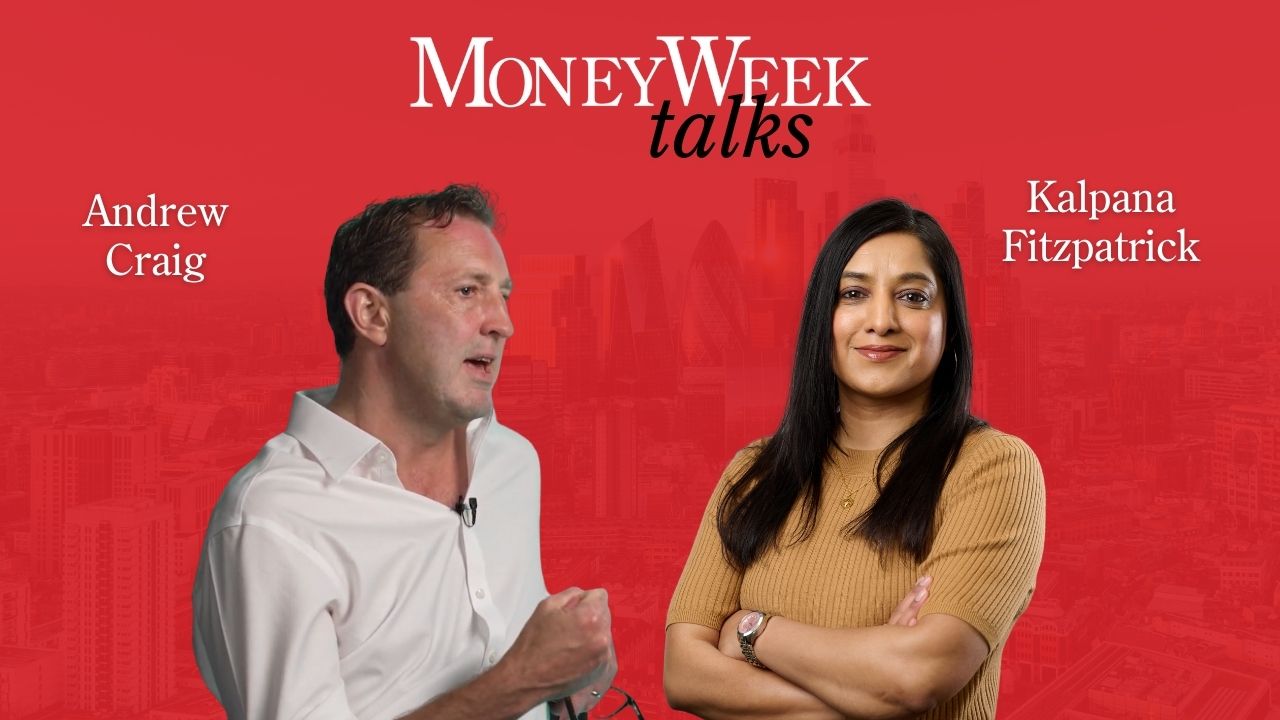Magnificent Seven results: Amazon shares gain 13% overnight
AI hype has propelled the Magnificent Seven stocks to the pinnacle of the stock market. Amazon shares soared in after-hours trading after its cloud arm AWS posted its strongest quarterly growth since 2022.


Tech stocks have been in vogue for most of the last decade, and the ‘Magnificent Seven’ in particular have been the stock market’s shining stars since ChatGPT launched in November 2022.
These seven stocks, viewed by many as being at the forefront of the artificial intelligence (AI) boom, have been among the most-bought stocks for most of that period.
At the start of 2023, the seven tech companies collectively comprised approximately 20% of the S&P 500 between them. Now, they make up more than a third (36%) of the index.
MoneyWeek
Subscribe to MoneyWeek today and get your first six magazine issues absolutely FREE

Sign up to Money Morning
Don't miss the latest investment and personal finances news, market analysis, plus money-saving tips with our free twice-daily newsletter
Don't miss the latest investment and personal finances news, market analysis, plus money-saving tips with our free twice-daily newsletter
That dominance of the stock market means that even beginner investors will have a lot of exposure to these companies through stock market trackers. Those who don’t invest actively will still have a lot of money riding on the Magnificent Seven stocks through their pension.
And while some are starting to question the longevity of the AI boom, and whether or not the AI megacap bubble could burst, these companies keep defying the doubters with standout results and earnings growth.
AI is “driving trillions [of dollars] of spending over the next few years and thus will keep this tech bull market alive for at least another two years in our view,” said Dan Ives, head of global technology research at Wedbush Securities.
Rapid growth in Amazon’s cloud business, Amazon Web Services (AWS) underscored the strength of this demand.
“AWS is growing at a pace we haven’t seen since 2022, reaccelerating to 20.2% year-on-year,” said Amazon’s president and CEO Andy Jassy following the company’s Q3 results on 30 October. The acceleration in AWS revenue growth saw Amazon shares pop more than 12% in after-hours trading following the results.
With Magnificent Seven earnings season now underway, how are the fundamentals of the companies leading the AI bull market holding up?
Magnificent Seven results
As of 31 October, six of the Magnificent Seven (Tesla, Alphabet, Meta, Microsoft, Amazon and Apple) have announced results for the third quarter of the 2025 calendar year, with only Nvidia left to announce its results, scheduled for 19 November.
Alphabet
Revenue at Google’s parent company rose 16% year-over-year to $102.3 billion, passing the $100 billion milestone for the first time and beating FactSet consensus expectations of $99.9 billion. Google Cloud revenue increased 34% to $15.2 billion and Google Search revenue increased 14.5% to $56.6 billion, defying doubts that Google’s core revenue driver is under threat from AI.
“AI Overviews and AI Mode are clearly resonating with users,” said Matt Britzman, senior equity analyst at Hargreaves Lansdown. “With ChatGPT’s recent browser demo falling short of a game-changer, Google looks well placed to put up a strong defence as gatekeeper to the internet.”
Earnings per share (EPS) also demonstrated robust growth of 35.4% to $2.87, comfortably beating analyst expectations of $2.27, to mark a strong night for Alphabet. GOOGL shares gained more than 7% in after hours trading following the results.
Amazon
Amazon announced its results after US markets closed on 31 October, reporting a 13% increase in net sales to $180.2 billion and a 36% increase in EPS to $1.95, beating analyst forecasts of $177.9 billion and $1.57 respectively.
AWS revenue’s return to growth was the highlight, though. “Cloud revenue jumped 20% year-over-year to $33 billion, the fastest growth since 2022, helping to ease some fears that Amazon is falling behind its rivals,” said Britzman.
“The message from management was clear: demand for computing power, especially for AI, is exploding,” Britzman added. “With billions going into new infrastructure and custom chips, the cloud battle is only getting more intense.”
Amazon shares traded 13% above their 30 October close during premarket trading on 31 October.
Apple
Apple announced its results at the same time as Amazon and, while more subdued, the market response was also positive with shares gaining around 2% overnight.
Apple’s revenue rose 8% to $102.5 billion while EPS increased 13% to $1.85, with revenue a shade ahead of analysts’ expected $102.2 billion and earnings beating the expected $1.78 by 3.9%.
Ives, from Wedbush Securities, upped his price target to $320 from $310 following the results, encouraged by “strength in the new iPhone 17 lineup along with continued strong services growth”.
While total iPhone revenue of $49.03 billion was slightly below analysts’ expectations of $50.15 billion, the figures only included one week’s worth of iPhone 17 sales (for the quarter ended 27 September). iPhone 17 sales are reportedly on track to outpace the iPhone 16 cycle, despite facing some supply constraints.
Ives noted, though, that “tariffs… remain a headwind to margins as Apple saw a ~$1.1 billion impact to profits”. Most iPhones sold in the US are now manufactured in India given strained US-China trade relations.
Meta
Shares in Meta fell more than 8% overnight following its earnings release on 29 October.
Revenue increased 26% to $51.2 billion, beating expectations of $49.5 billion, but EPS fell 83% to $1.05 thanks to a one-time tax charge of $15.9 billion. Without this charge, EPS would have come in at $7.25, which would have exceeded analysts’ estimates of $6.72.
Given the impact of the tax charge it appears to be lower growth forecasts and increased capex spend that dented investor sentiment towards Meta. Meta increased its capital spend projections for 2025 to $70-72 billion in order to fund data centre buildouts.
“[Mark] Zuckerberg [CEO of Meta] is betting heavily on AI infrastructure, which means profits will likely come under pressure in the near term,” said Britzman. “He argues this is essential to secure a bigger long-term opportunity, but the trade-off is clear: higher costs now for uncertain future gains.”
“Investors are rewarding companies demonstrating discipline and punishing those overextending on promises of AI-driven growth,” said Nigel Green, chief executive of deVere Group.
Microsoft
Microsoft’s shares fell over 2.5% overnight following its results on 29 October. Revenue increased 18% to $77.7 billion, ahead of analysts’ expected $75.4 billion, while non-GAAP EPS increased 23% to $4.13 compared to $3.67 expected by analysts.
“The market response was muted because Azure growth came in slightly below very high expectations,” said Britzman. Revenue for Azure, Microsoft’s cloud service platform, increased 40%, or 39% in constant currency terms, which Britzman described as “exceptional” if the over-exuberant expectations are ignored.
“This was another solid quarter,” said Ives, “putting the company well on its way to join the $5 trillion club over the next 18 months.”
Nvidia
Nvidia became the first member of that $5 trillion club on 29 October off the back of news that it has an orders backlog worth $500 billion through to the end of next year, as well as renewed optimism over US-China trade restrictions easing.
Nvidia doesn’t announce results until 19 November. Analysts polled by FactSet expect EPS of $1.24 on revenue of $54.6 billion.
Tesla
Tesla’s results were announced on 22 October, and while the company posted record revenue of $28 billion, this was largely boosted by a rush to buy its electric vehicles before tax credits expire. Adjusted EPS fell 31% to $0.50, and shares fell around 4% immediately after the results, though they closed 23 October higher than their last price before the results were announced.
What are the Magnificent Seven stocks?
The Magnificent Seven – often abbreviated to ‘Mag7’ – comprises seven big tech stocks that the investing community perceives as being the leading exponents of technology in general and AI in particular.
They are:
- Alphabet (NASDAQ:GOOGL) – the parent company of Google, as well as other companies such as the AI developers DeepMind and Anthropic;
- Amazon (NASDAQ:AMZN) – originally an online bookstore, now a giant of e-commerce and cloud computing via AWS;
- Apple (NASDAQ:AAPL) – the tech hardware company that brought the world the MacBook and the iPhone;
- Meta (NASDAQ:META) – formerly Facebook, the company is now heavily focused on ‘Metaverse’ technology as well as AI products, like the Llama model;
- Microsoft (NASDAQ:MSFT) – the computing giant behind the Windows operating system and the Azure cloud platform;
- Nvidia (NASDAQ:NVDA) – the hardware developer that pioneered GPUs, the chips that power AI data centres;
- Tesla (NASDAQ:TSLA) – the electric vehicle (EV) manufacturer that launched its long-awaited self-driving car service in Austin, Texas this year.
The term ‘Magnificent Seven’ was coined by Bank of America analyst Michael Hartnett in 2023. By then, the group was already starting to dominate the stock market in the wake of the AI and tech stock mania that followed the public launch of ChatGPT in late November 2022.
While most of the group are highly diversified (Amazon is an e-commerce company as well as the world’s largest cloud services provider; Alphabet makes phones, self-driving cars and owns YouTube in addition to its cloud computing division and its core internet search business), AI is their unifying feature as a group.
Some (like Nvidia) sell the hardware that underpins AI, or the cloud services on which models are trained and distributed (Amazon, Microsoft and Alphabet hold a 60% share of the global cloud market between them). Others develop AI platforms, such as Meta’s Llama or Microsoft’s Copilot, or integrate ‘physical AI’ into robotics and self-driving cars (especially Tesla).
They are stock market behemoths; all have a market capitalisation (market cap) over $1 trillion as of 29 October.
Should you invest in the Magnificent Seven?
Investors pay a premium for the earnings growth power of the Magnificent Seven stocks; most of them trade at earnings multiple above those of the broader market thanks to their position as figureheads of the AI boom.
“AI is likely to be as transformative as the internet, the computer, trains or even electricity,” says Andrew Oxlade, director, personal finance and markets at Fidelity International. “The question is not whether it matters, but whether today’s winners justify their share prices. History suggests that in every great innovation cycle, investors get carried away.”
The table below shows the price of these stocks relative to their earnings over the last 12 months (trailing) and analysts’ projections for the next 12 (forward). Note that these don’t factor in price movements that occurred after results announced on 29 October.
Stock | Trailing P/E ratio | Forward P/E ratio |
|---|---|---|
Alphabet* | 26.2 | 23.3 |
Amazon* | 33.9 | 28.6 |
Apple* | 39.0 | 32.1 |
Meta* | 26.4 | 24.6 |
Microsoft* | 37.8 | 33.3 |
Nvidia* | 53.8 | 29.9 |
Tesla* | 259.5 | 172.4 |
S&P 500 average^ | 25.6 | 22.1 |
NASDAQ 100 average^ | 33.3 | 27.9 |
Sources: *Yahoo Finance as of market close on 30 October 2025. ^Birinyi Associates analysis via Wall Street Journal as of 24 October 2025.
At present, Alphabet and Meta are both trading at similar levels to the broader S&P 500 and are cheaper than most NASDAQ 100 stocks in comparison to their previous and expected earnings.
Get the latest financial news, insights and expert analysis from our award-winning MoneyWeek team, to help you understand what really matters when it comes to your finances.

Dan is a financial journalist who, prior to joining MoneyWeek, spent five years writing for OPTO, an investment magazine focused on growth and technology stocks, ETFs and thematic investing.
Before becoming a writer, Dan spent six years working in talent acquisition in the tech sector, including for credit scoring start-up ClearScore where he first developed an interest in personal finance.
Dan studied Social Anthropology and Management at Sidney Sussex College and the Judge Business School, Cambridge University. Outside finance, he also enjoys travel writing, and has edited two published travel books.
-
 The investing mistakes not to make: MoneyWeek Talks
The investing mistakes not to make: MoneyWeek TalksPodcast MoneyWeek's digital editor speaks to Andrew Craig, founder of Plain English Finance, about why passive investing isn't always the only option for good investors
-
 Household savings ratio drops – are you setting enough aside for 2026?
Household savings ratio drops – are you setting enough aside for 2026?High inflation has pushed the savings ratio down again and the figure could dip further next year
-
 Metals and AI power emerging markets
Metals and AI power emerging marketsThis year’s big emerging market winners have tended to offer exposure to one of 2025’s two winning trends – AI-focused tech and the global metals rally
-
 Quality emerging market companies with consistent returns
Quality emerging market companies with consistent returnsOpinion Mark Hammonds, portfolio manager at Guinness Global Investors, selects three emerging market stocks where he'd put his money
-
 Coreweave is on borrowed time
Coreweave is on borrowed timeAI infrastructure firm Coreweave is heading for trouble and is absurdly pricey, says Matthew Partridge
-
 An AI bust could hit private credit – could it cause a financial crisis?
An AI bust could hit private credit – could it cause a financial crisis?Opinion Private credit is playing a key role in funding data centres. It may be the first to take the hit if the AI boom ends, says Cris Sholto Heaton
-
 The top stocks of 2025 - did you pick a winner?
The top stocks of 2025 - did you pick a winner?As a chaotic year in the stock market draws to a close, we review which stocks were investors’ top picks for 2025
-
 Why Trustpilot is a stock to watch for exposure to the e-commerce market
Why Trustpilot is a stock to watch for exposure to the e-commerce marketTrustpilot has built a defensible position in one of the most critical areas of the internet: the infrastructure of trust, says Jamie Ward
-
 Which sectors are best to invest in for 2026?
Which sectors are best to invest in for 2026?Investment trust portfolio managers give their views on the sectors and regions they expect to outperform in 2026.
-
 ChatGPT turns three: what’s next for the ‘AI era’?
ChatGPT turns three: what’s next for the ‘AI era’?Three years after its launch kickstarted the age of AI, ChatGPT and its maker OpenAI are driving the stock market. But concerns are growing over whether OpenAI will be able to turn its AI dominance into profit.